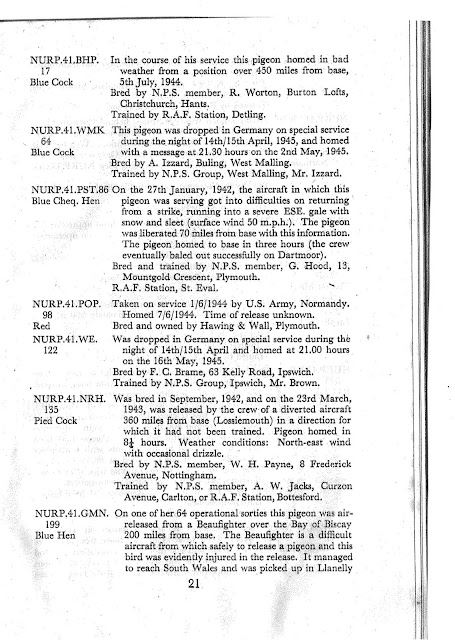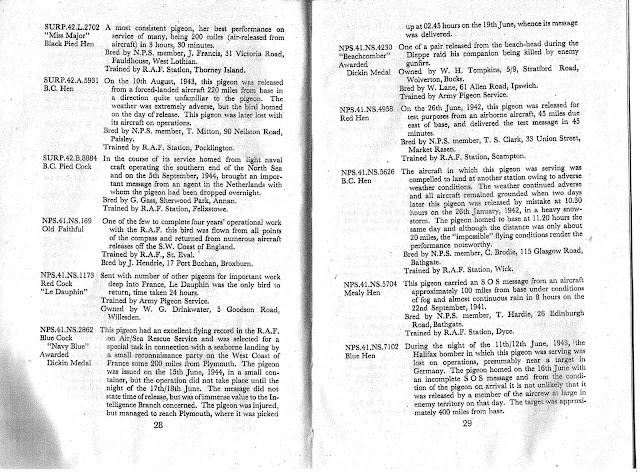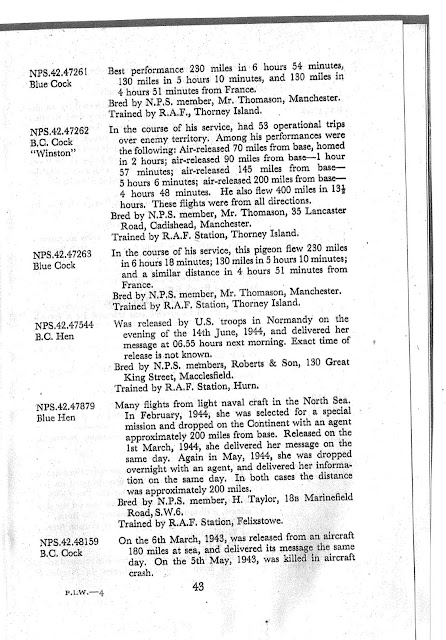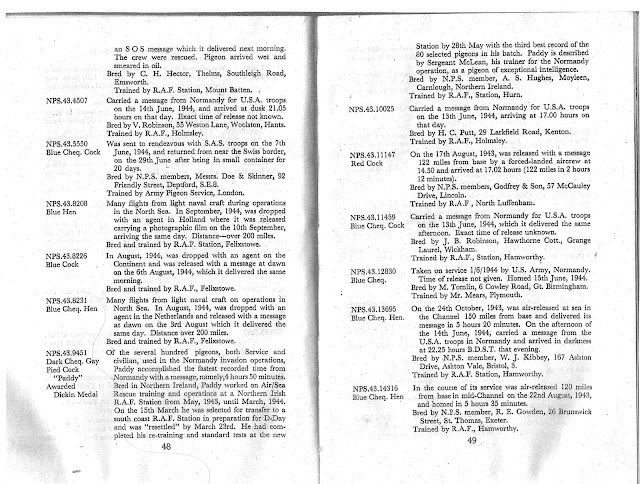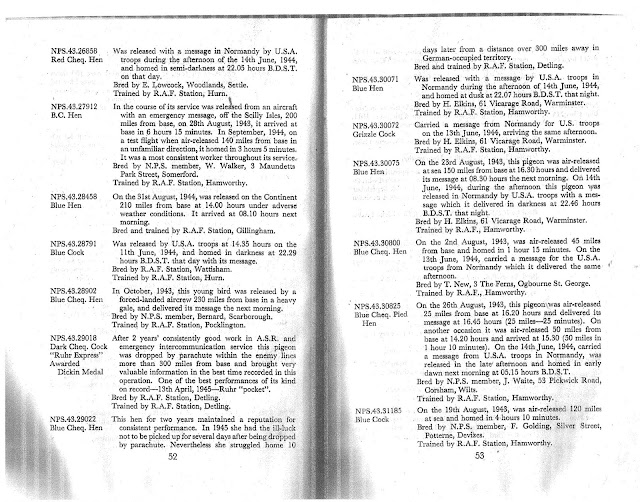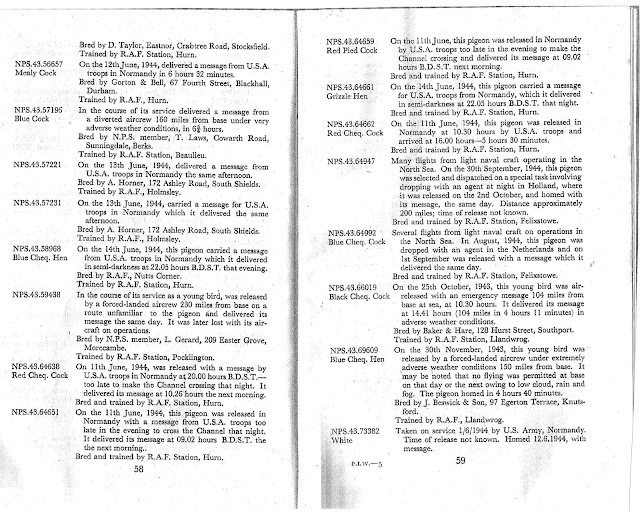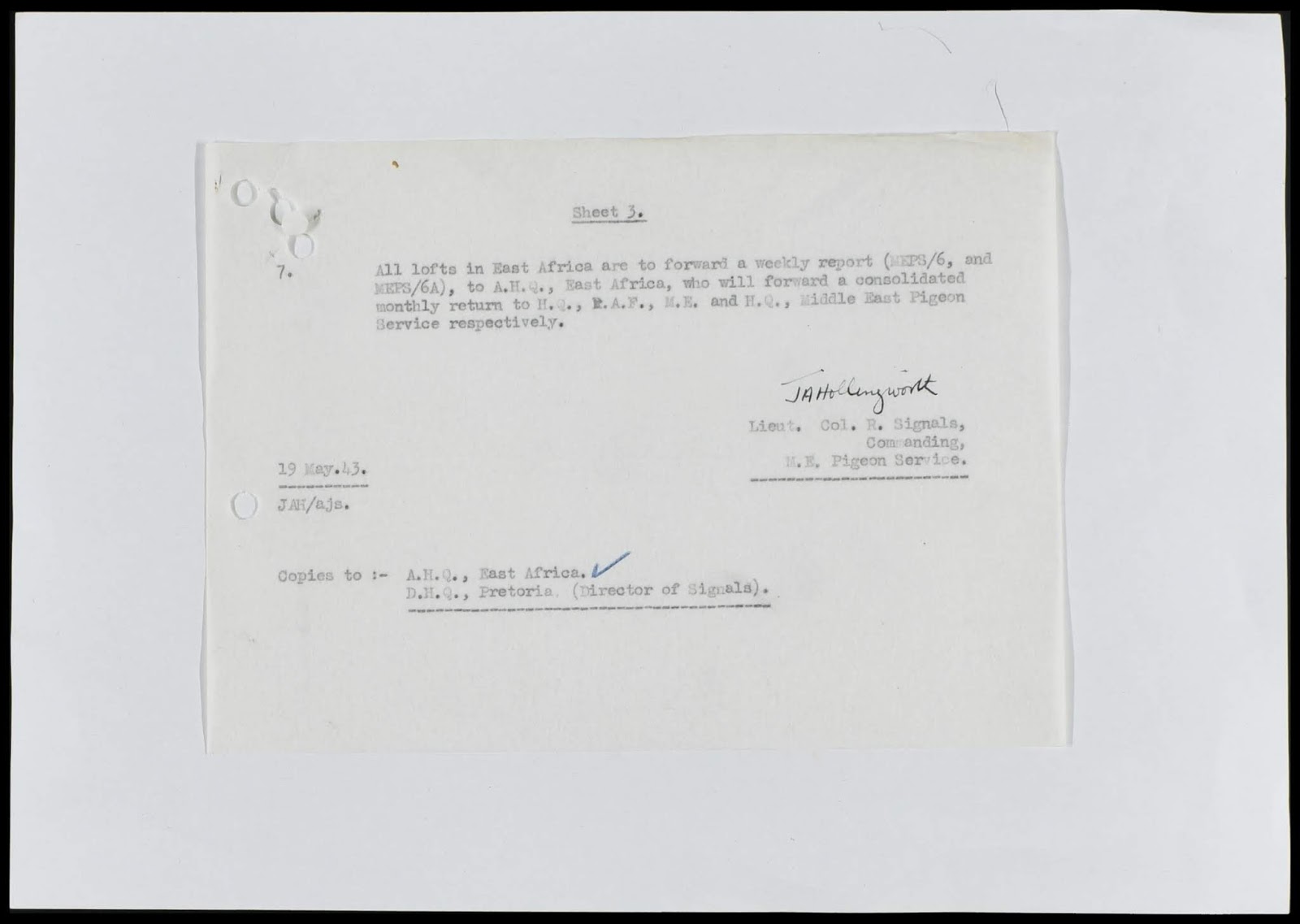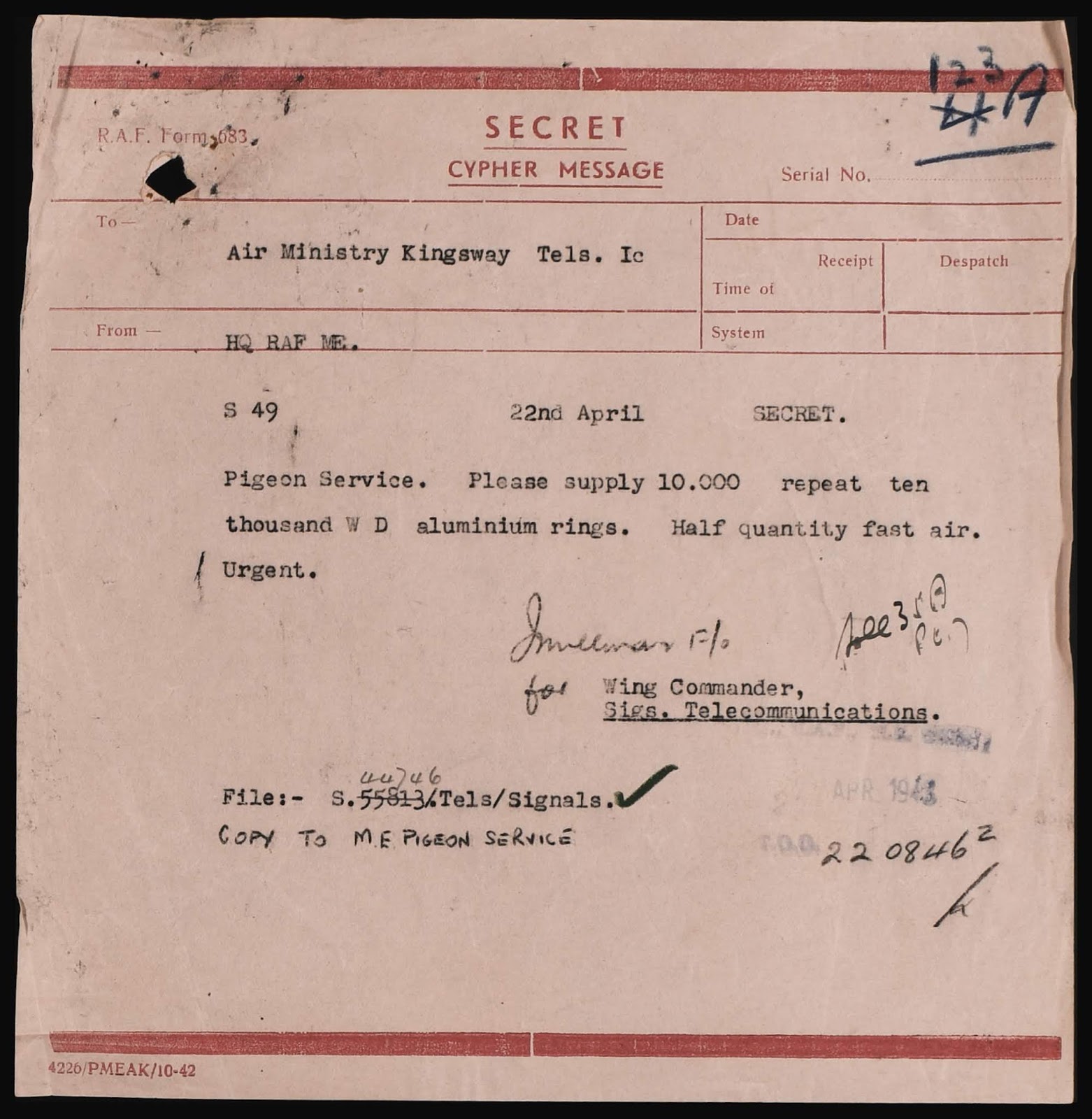Photos and the Meritorious Performance List from Major W. H. Osman’s book Pigeons in World War II published in 1950 by The Racing Pigeon Publishing Co. Ltd. courtesy of The Racing Pigeon Co Ltd. www.racingpigeon.co.uk.
Friday, May 31, 2019
Saturday, May 25, 2019
Pigeons in Africa, May 1943
(c) Crown copyright images reproduced by courtesy of The National Archives, Kew, UK
Catalog numbers: AIR23/6546 #02, #10, #11, #12, #14, #15, #17, #21, #22, #23
You can use the scroll bar at bottom to center the documents.
You can use the scroll bar at bottom to center the documents.
RAF Operations in the Middle East and Africa, 1940-43
Camels at work with their drivers during levelling operations on the airfield at Khormaksar, Aden. Note the red warning flags attached to the camels' yokes to alert aircraft in the area. Photo by RAF Khormaksar. Imperial War Museum © IWM (CM 5378)
Kenya Supplies Bacon for Middle East Troops, C. 8 October 1942
The expanding Uplands Bacon Factory in Kenya can now handle 500 pigs weekly. Half of its total bacon produce is packed in wooden cases and dried salt, to save refrigeration space, and exported to the Army in the Middle East. Both dry and tank methods of curing are employed and the factory specialises in Wiltshire Cured Bacons and Hams. Sausages and tinned produces are made in large quantities. The factory suplies Tanganyika Territory, Uganda, Congo, Seychelles and Zanzibar, and, after the war, intends to export full Wiltshire sides of green (unsmoked) bacon to the English market. Picture shows:- Sausage making machine. Imperial War Museum © IWM (K 3198)
Tuesday, May 21, 2019
75th Anniversary of D-Day
In Courageous Couriers: Memoirs of a Pigeon Soldier, Lt. Col. (retired) Jerome J. Pratt explains the mission of the 2nd platoon of the 280th Signal Pigeon Company. Led by Lieutenants Thomas H. Spencer and Irwin F. Salz, 45 enlisted men and 1391 pigeons landed in Britain on September 12, 1942, where they would establish the Pigeon Breeding Center at Tidworth Barracks.
“As its tactical mission, the platoon was responsible to train pigeons for communications from the shores of Normandy to the United Kingdom. Some 500 birds landed with our troops on D-Day. They were immediately put to work carrying ammunition status reports, undeveloped photographic film, and emergency messages.
When the members of the 165thSignal Photographic Company stormed ashore with the invading forces they had three crates of pigeons with them. The pictures of our landing operations to reach England for the first few days after the invasion arrived by pigeon.”
A pigeon saves the lives of the men who took out the Merville gun battery
This is Lieutenant Colonel Terence Otway, Commanding Officer, 9th Battalion, Parachute Regiment, concluding his account of the successful destruction of the Merville gun battery on D-Day. You can listen to his entire account by going to The Imperial War Museum’s site, iwm.org and searching Otway in the sound archive. This operation commenced at 2:15am.
“By five o’clock we had completely occupied the battery. We had taken all the casements, we had taken twenty-two prisoners and there were a lot of German casualties, killed and wounded, in the casements, and I was able to send a success signal. I had no radio to send a success signal but I lit a yellow signal flare and an RAF plane went over, saw it, and waggled its wings. And my signals officer, unbeknown to me, had got a carrier pigeon with him, brought in all the way from England in his airborne smock, and he tied a victory message around its leg and sent it off.
Then the problem was to get out. I went round the casements and I told all the troops to get out but we didn’t know how to get through the minefield so I told the prisoners to show me the way. They refused. So I said, ‘Well, OK, we’re going to make you walk forward and if you don’t show us the way through the mines we’re just going to start shooting the ground and you’re going to lose your feet and maybe the mines will go up too.’ So they showed us the way and we got out.
I went and sat by the cavalry near the battery and I told everybody to take up defensive positions such as we were able to. Because, out of the 150 men that we went in with, all ranks, there were only 75 of us left standing on our feet. The others had been killed or wounded.”
The Western Front Committee was established at Bletchley Park in October 1942 and for the next 18 months built up a comprehensive picture of German forces in the West, recording every unit, its location and its strength.
Link to Bletchley Park May Podcast 88-The Tide of Victory
Description of the podcast from the Bletchley Park site:
It Happened Here this month takes us to a Britain whose south coast in May 1944 resembled one huge army camp as over two million men waited for D-Day. In the Buckinghamshire countryside, the staff at GC&CS carried on feeding detailed and crucial intelligence to the Allied forces that would play an integral part in the success of the upcoming Operation Overlord.The Western Front Committee was established at Bletchley Park in October 1942 and for the next 18 months built up a comprehensive picture of German forces in the West, recording every unit, its location and its strength.
Royal Air Force: Operations by the Photographic Reconaissance Units, 1939-1945
Annotated vertical photographic-reconnaissance aerial taken over Auderville on the Cap de la Hague peninsula, France; the first of a series of reconnaissance photos which provided evidence that the Germans were employing early-warning radar. The ringed circular objects, at first thought to be cow bins, were examined by Dr R V Jones, the Assistant Director Air Intelligence (Science) at the Air Ministry, in January 1941. From this he conjectured that the circles may house 'Freya' aerial arrays, a fact confirmed by subsequent low-level sorties undertaken by No. 1 PRU. Photo taken by W.K. Manifould (Pit Off), No. 1 Photographic Reconnaissance Unit, Royal Air Force Official Photographer. Imperial War Museum © IWM (C 5474)
Remembering A Pilot
R.V. Jones served as Assistant Director of Intelligence (Science) in the Air Ministry. At the end of the chapter on D-Day in his book Most Secret War, Jones explains the importance of the bombings which took out the German radar and jamming stations.
“Not only had we eliminated the jammers and the headquarters of the German Signals Intelligence Service in north-west France which might otherwise have detected our movements on Day D-1, but we had knocked out large proportions of the German radar chain….
Reviewing the results, Sir Trafford Leigh Mallory, the Allied Expeditionary Air Force Commander, said in his Official Despatch (London Gazette, 2 January, 1947):
The application of radio counter measures immediately preceding the assault, proved to be extraordinarily successful….These results may be summarized as follows: the enemy did not obtain the early warning of our approach that his Radar coverage should have made possible; there is every reason to suppose that Radar controlled gunfire was interfered with; no fighter aircraft hindered our airborne operations; the enemy was confused and his troop movements were delayed.
And as for the attack we had thrown in for good measure along with those on the five jammers the Despatch said:
The success of this last attack on the Headquarters of the German Air Force Signals Intelligence must have been a major catastrophe for the enemy, and it may well be that it was an important contributory factor to the lack of enemy air reaction to the assault.
But there was a cost. As the Official Despatch said, ‘These Radar targets were very heavily defended by flak, and low level attacks upon them demanded great skill and daring….losses among senior and more experienced pilots were heavy.” In one case, that of an attack on a ‘hoarding’ on the Hague Peninsula, I received a German eye-witness account: three of our fighters had attacked in line astern, and one was hit by flak. The pilot had dived his aircraft into the hoarding, finishing it—and himself—forever. The German said it was the bravest thing he had ever seen. It was agreed on the Air Staff that if I could find who the pilot was I should write a citation for a posthumous Victoria Cross; but two of the three aircraft in the attack had crashed with their pilots lost, and we could not establish which was the aircraft which had destroyed the hoarding.
The Official Despatch concluded: ‘These attacks saved the lives of countless soldiers, sailors and airmen on D-Day.”
Link to Roosevelt’s Fireside Chat 29: On the Fall of Rome, June 5, 1944:
https://millercenter.org/the-presidency/presidential-speeches/june-5-1944-fireside-chat-29-fall-rome
Link to D-Day real time radio broadcasts:
https://www.wwiifoundation.org/students/real-time-radio-broadcasts-from-d-day-june-6-1944/
Link to President Roosevelt’s D-Day prayer (cut 44):
https://archive.org/details/NBCCompleteBroadcastDDay/CBD-440606_NBC2200-PresidentRooseveltD-DayPrayer.mp3
Newsreel: Preparations for D-Day
Newsreel: Preparations for D-Day
This video was too long to load to the World War II Pigeons site so here is the link to watch the British Pathe newsreel, Stores of War Materials at the Ready for D-Day:
https://www.britishpathe.com/video/VLVAJI75D1Z6NMFJAUO44446KSUI-STORES-OF-WAR-MATERIALS-AT-THE-READY-FOR-D-DAY/query/D-Day
Gustav in safe hands after his adventurous flight. 1944
PIGEON BRINGS FIRST INVASION NEWS Gustav, an RAF Coastal Command carrier pigeon, brought the first War Correspondent's dispatch back to England from the Allied Invasion forces off the enemy coast, and the bird was released at 8:30 in the morning. Flying against a 50 mile an hour head wind, the pigeon landed in its loft on a south coast Coastal Command Station at 1:46 in the afternoon. The message was immediately telephoned to London for publication. It read: "We are just twenty miles or so off the beaches. First assault troops landed 0750. Signal says no interference from enemy gunfire on beach. Passage uneventful. Steaming steadily on. Formations Lightnings, Typhoons, Fortresses crossing since 0545. No enemy aircraft seen." Imperial War Museum © CH 13321
Friday, May 10, 2019
Pigeons in question duly arrived and youngsters ready for South Africa, 1943
RAF Operations in the Middle East and North Africa, 1939-43
Captured Messerschmitt Bf 110D "The Belle of Berlin" in British markings on a landing ground in North Africa. This aircraft served with II/ZG76 in Iraq and was captured after crash-landing near Mosul in May 1941. It was used as a communications aircraft and later as a unit 'hack' by No.267 Squadron RAF. Photo by Royal Air Force official photographer. Imperial War Museum. © IWM (ME(RAF) 2628)
(c) Crown copyright images reproduced by courtesy of The National Archives, London, UK
Catalog numbers: AIR23/998
#04, #13, #15, #17, #18, #19, #20, #21, #22, #27, #29, #30
Subscribe to:
Comments (Atom)









